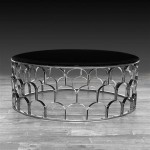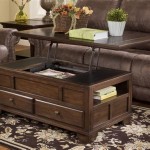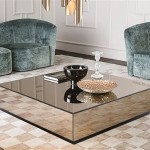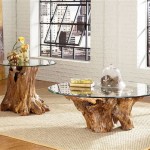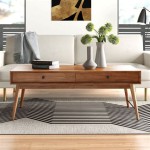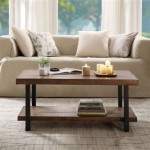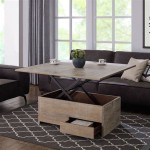What's The Best Height for a Coffee Table?
The selection of a coffee table for a living room or seating area often involves considering factors such as style, material, and size. However, one of the most critical, yet often overlooked, aspects is the height of the table. The optimal coffee table height significantly impacts both the aesthetics and functionality of the space, influencing comfortable reach, visual harmony, and overall usability. Choosing the "best" height is not a matter of a single, universally applicable measurement, but rather a careful consideration of several influencing variables.
A coffee table serves as a central focal point within a seating arrangement. It acts as a surface for placing drinks, books, remote controls, and decorative items. It can also contribute to the overall visual appeal of the room, completing the design scheme and tying together various elements. However, if the coffee table's height is ill-suited to the surrounding furniture, it can disrupt the flow of the space, create visual imbalance, and render it less functional. Therefore, understanding the elements that go into determining the optimal height is paramount.
Matching Coffee Table Height to Sofa Seat Height
One of the primary guidelines for selecting an appropriate coffee table height involves matching it to the height of the sofa or other seating elements. Ideally, the coffee table should be approximately the same height as the seat cushions of the sofa. This provides a comfortable and accessible surface for users to reach without straining or leaning excessively. A surface that is at or slightly below the seating height allows for easy placement of objects and encourages natural interaction within the seating area.
If the sofa has a seat height of 18 inches, a coffee table with a height between 16 and 18 inches would generally be suitable. Similarly, a sofa with a seat height of 20 inches would pair well with a coffee table in the 18 to 20 inch range. This approach ensures ergonomic comfort and promotes unrestricted movement around the area. In situations where the sofa's seat height is unusual, adjustments to the coffee table height may be necessary to maintain proportionate and comfortable arrangement.
Variations in sofa designs also influence coffee table height selection. Sofas with low-slung designs may require lower coffee tables, while higher sofas may require taller ones. Consideration should also be given to the overall style of the sofa. A modern, minimalist sofa may complement a lower, sleek coffee table, while a traditional, more ornate sofa may accommodate a more substantial, slightly higher table. By carefully coordinating the heights of the coffee table and sofa, interior designers can create cohesive and ergonomically sound living spaces.
Accounting for Personal Preferences and Usage
While matching the sofa's seat height provides a foundational guideline, personal preferences and the intended use of the coffee table should also be considered. Individuals who frequently use the coffee table for dining or working may prefer a slightly taller table. A higher surface can provide a more comfortable position for eating or typing, reducing strain on the neck and back.
If the coffee table primarily serves as a decorative element, a lower table may be more suitable. Lower coffee tables can create a sense of spaciousness and openness in a room, highlighting other design elements. They can also accentuate the lines and proportions of the surrounding furniture, contributing to a more visually appealing arrangement. The decision to prioritize aesthetics over functionality should be balanced against ergonomic considerations, ensuring that the table remains usable and accessible.
Different lifestyles and household needs also play a role in coffee table height selection. Households with children may opt for a coffee table with rounded edges and a lower height to minimize potential injuries. Alternatively, individuals with limited mobility may benefit from a taller table that is easier to reach and less physically demanding to use. By factoring in the unique characteristics and usage patterns of each household, an appropriate coffee table height can be selected that contributes to both comfort and safety.
Furthermore, the presence of other furniture items in the room can influence the ideal coffee table height. For example, if the living room includes armchairs or ottomans, the coffee table's height should be proportional to these elements as well. The intention is to create a harmonious blend of furniture heights that support a comfortable and functional seating area. The goal is to create a balanced and visually appealing arrangement where all elements work together to enhance the overall experience of the space.
Considering Table Size and Room Proportions
Determining the ideal coffee table height extends beyond the vertical alignment with the sofa. The size of the table in relation to the available floor space and the overall proportions of the room are also critical considerations. A coffee table that is too large or too small can disrupt the visual balance and functionality of the space, regardless of its height.
In smaller rooms, a lower coffee table can help to create a more open and airy feel. Lower tables tend to visually recede, making the room appear larger than it is. Conversely, in larger rooms, a slightly taller coffee table can contribute to a sense of groundedness and stability. The table can serve as an anchor, preventing the space from feeling too vast or empty. The size of the table should also be proportionate to the seating elements; a small love seat would be overwhelmed by a large and tall coffee table, while a large sectional sofa would require a more substantial table to maintain balance.
The shape of the coffee table can also impact the perceived height. Round or oval tables often appear less bulky than rectangular or square tables of the same size. Therefore, a round coffee table may be perceived as being lower than a rectangular table with the same measured height. When assessing the suitability of a coffee table, it is essential to consider both its dimensions and its shape in relation to the surrounding furniture and the room's overall proportions. This comprehensive approach can result in a more aesthetically pleasing and functional arrangement.
In addition to the visual impact, the size of the coffee table also affects its functionality. A larger table provides more surface area for placing items, while a smaller table may be sufficient for holding only a few essential items. The intended use of the table should be considered when determining its appropriate size. If the table is to serve as a focal point for decorative displays, a larger surface area may be desirable. If it is primarily intended to hold drinks or remote controls, a smaller table may be adequate. Balancing function and aesthetics is essential for creating a space that is both visually appealing and practical.
The material used to construct the coffee table can also affect the perception of its height. Tables made of heavier materials, such as solid wood or stone, may appear more substantial and imposing, even if they are the same measured height as tables made of lighter materials. Conversely, tables made of glass or metal may appear more lightweight and less visually obtrusive. By considering the visual weight of the table's material, an appropriate height can be selected that complements the surrounding furniture and the overall design scheme of the room.
Accessibility and clearances around the coffee table are also important considerations. Sufficient space should be left between the table and the seating elements to allow for comfortable movement. A general guideline is to leave at least 18 inches of space between the coffee table and the sofa. This clearance allows users to easily access the table and move freely around the seating area. In smaller rooms, the clearance may need to be adjusted to accommodate the available space, but care should be taken to avoid creating a cramped or cluttered environment.

How High Should A Coffee Table Be

Coffee Tables Guide Ez Living Interiors

Decorating Your Living Room Must Have Tips Home What Size Coffee Table Driven By Decor

How Big Should A Coffee Table Be Know The Fact House Of Nur

Adjustable Height Round Coffee Table To Dining Whole

Mid Century Modern Square Coffee Table By Lane Chairish

39 Modern Black Natural Coffee Table With Storage Shelf Light Wood And Metal Homary

Mobile C Table Height Adjustable Side With Storage Shelvesoak End Tables Shelves

Best Choice S 32in Bar Height Folding Table Indoor Outdoor Accessory W Thick Top 330lb Capacity White Com

What Is Standard Counter Height Bar Table Wfmo
Related Posts

